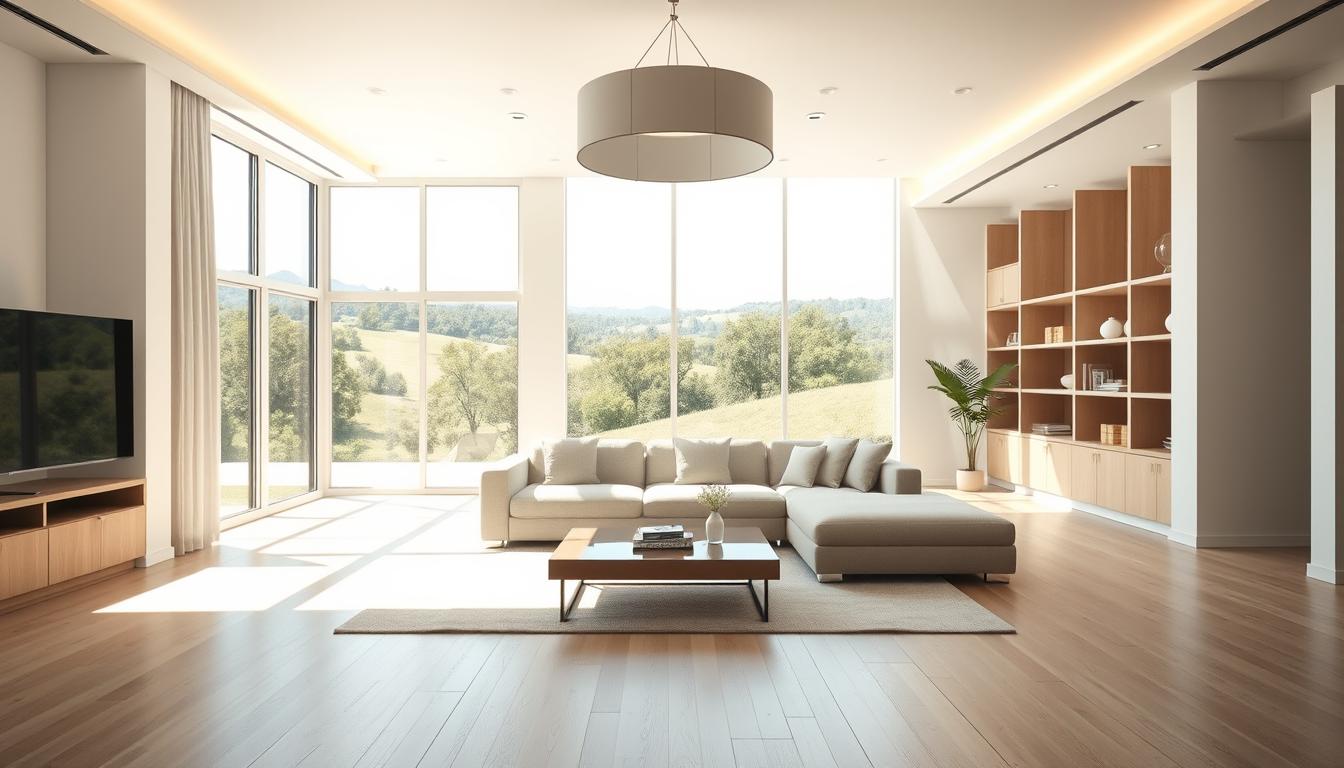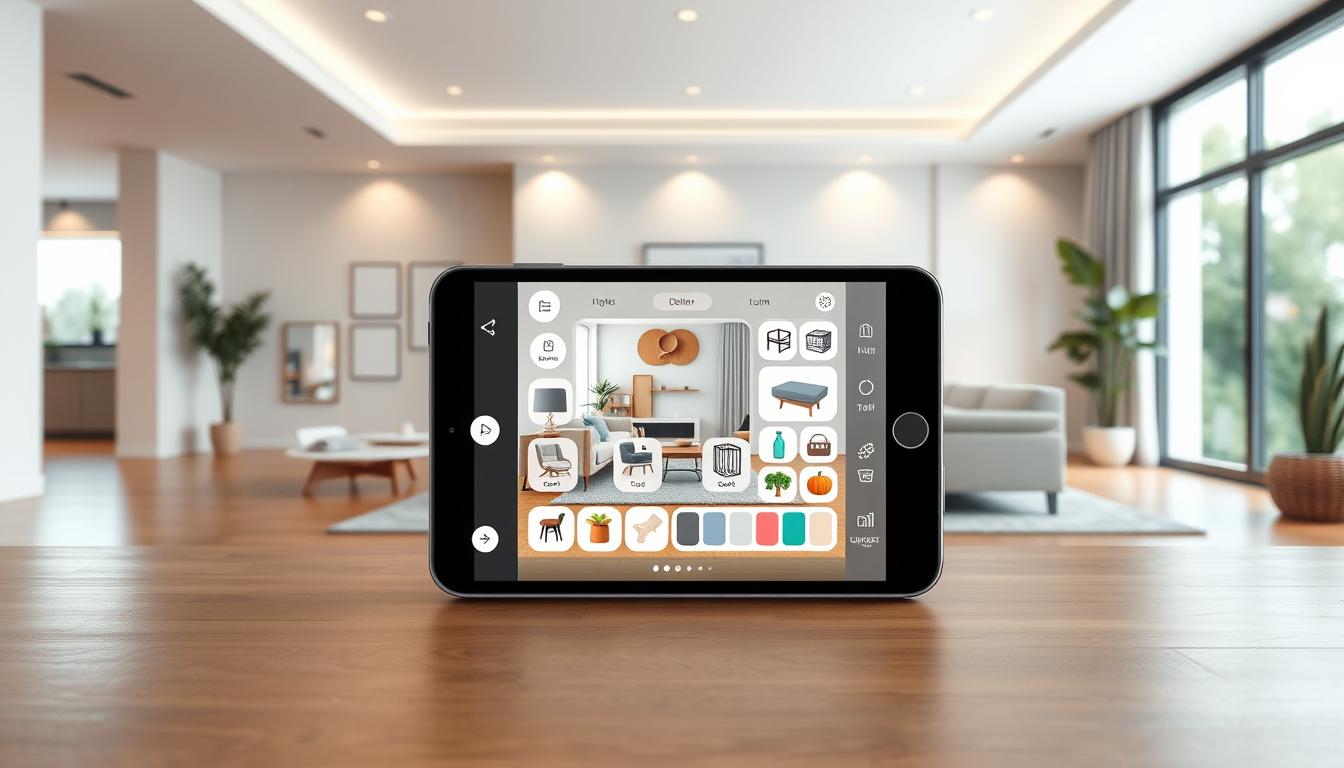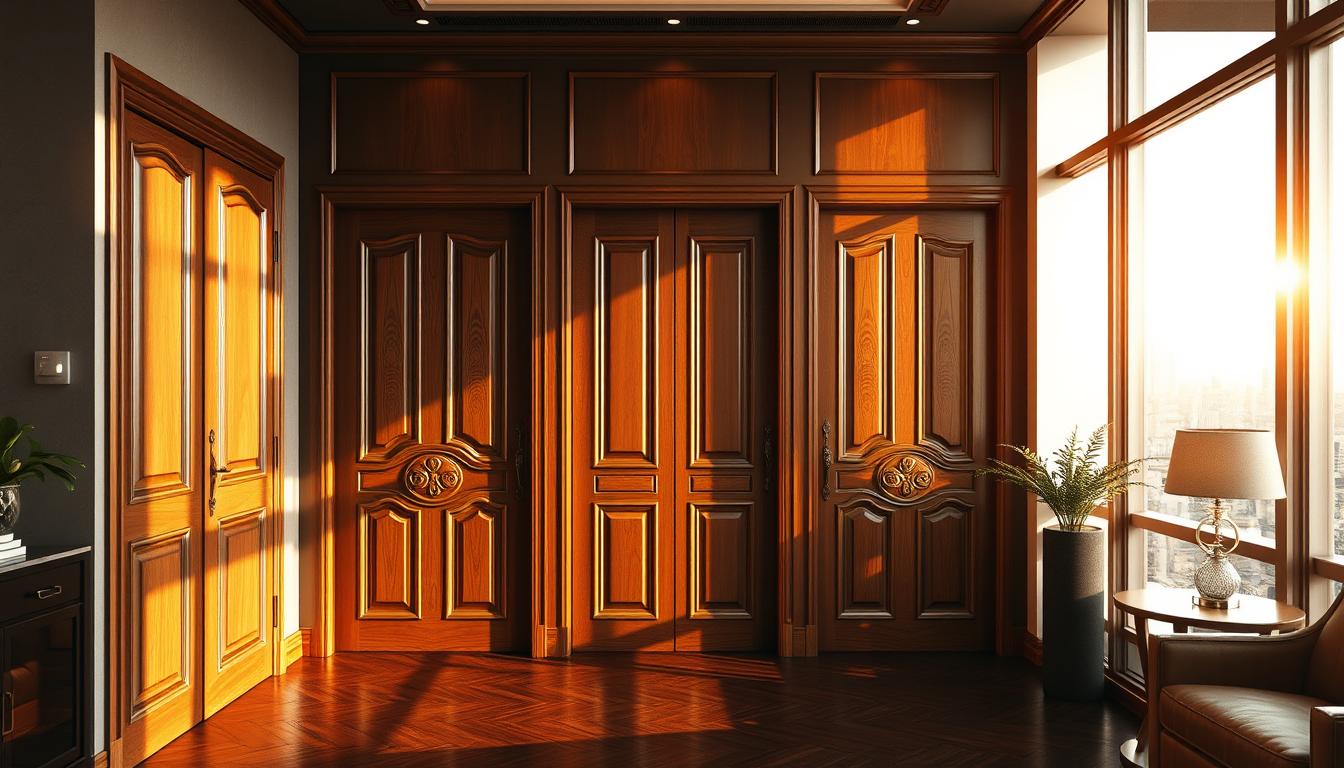Did you know modular homes are getting more popular? They’re affordable and can be customized. So, making your modular interior look good and work well is very important.
We’ll show you how to make a space that’s both beautiful and useful. Knowing how modular homes are built helps you use space better.
With our tips, you can make your modular space cozy and welcoming. It will feel like a real home.
Key Takeaways
- Understand the unique aspects of modular construction.
- Maximize space and functionality.
- Choose the right layout for your needs.
- Select a color scheme that enhances the space.
- Personalize your space with sustainable design practices.
Understanding Modular Homes
Modular homes are more than just buildings. They show off modern living and creative design. Built in a factory and put together on-site, they mix efficiency, quality, and personal touches. This way of building homes cuts down on construction time without losing quality.
What Are Modular Homes?
Modular homes are built in a factory, then moved to the site and put together. This method lets builders control the process better. It also means less delay from weather or other issues that can slow down building.
These homes are energy-efficient and strong, meeting or beating local building standards.
Key Features of Modular Homes
Modular homes stand out because of their customization options. Owners can pick from many designs, materials, and finishes. This lets them create a home that shows their style and meets their needs.
They also have advanced energy-saving features. These include good insulation, energy-saving windows, and modern heating and cooling systems.
- Customizable designs and layouts
- Energy-efficient features
- Durable construction
Benefits of Modular Living
Modular living has many advantages beyond just building. These homes are strong and easy to keep up. They’re great for those who want to live green and save money in the long run. Plus, they can be changed easily to fit different lifestyles and needs.
Learning about modular homes opens up new possibilities for your living space. Whether you dream of a cozy spot or a big family home, modular living has lots to offer.
Planning Your Modular Home Interior
Modular homes are like a blank canvas for your interior design. The first step is planning. We’ll help you through the process of modular home customization. You’ll learn how to make your space reflect your personality and meet your needs.
Assessing Your Space
Understanding your space is key to a functional and cozy home. We measure the rooms and think about how they’ll flow. It’s important to decide how you’ll use each area and how they’ll connect.
For ideas, check out Luxe Interior Co.. They have lots of tips on interior design and decor.
Think about the natural light in each room. It affects your design choices. Knowing your space’s strengths and weaknesses helps you make better decisions.
Setting Your Style Preferences
Choosing your style is a fun part of designing. Your modular home should show off your lifestyle and tastes. Create a mood board or collect images that inspire you.
Think about the colors, textures, and furniture that will make your home welcoming. Defining your style early ensures your home is both beautiful and comfortable.
Choosing the Right Layout
Designing the perfect modular home interior starts with choosing a layout that suits your lifestyle. The layout is key to both the home’s function and beauty.
You’ll face several options when deciding on a layout. You’ll mainly choose between an open concept and traditional spaces. Each has its own benefits and drawbacks.
Open Concept vs. Traditional Spaces
An open concept layout combines living, dining, and kitchen areas into one space. This design makes your home feel bigger and encourages family interaction. It’s great for smaller homes.
Traditional spaces, on the other hand, have separate rooms for different activities. This layout is perfect for those who want privacy and specific areas for tasks, like a home office or a quiet room.
Zoning for Functionality
Whether you pick an open concept or traditional layout, zoning for functionality is key. This means dividing your space into areas for living, cooking, dining, and sleeping. Good zoning makes each area work well without messing up the home’s flow.
| Zone | Activities | Design Considerations |
|---|---|---|
| Living Area | Relaxation, Entertainment | Comfortable seating, adequate lighting |
| Kitchen | Cooking, Food Preparation | Efficient layout, quality appliances |
| Dining Area | Meals, Socializing | Spacious enough for table and chairs, ambient lighting |
| Bedroom | Sleeping, Relaxation | Quiet, comfortable bedding, storage for clothing |
By thinking about your needs and preferences, you can make a modular home that looks great and works well. It will be a true example of the best modular home interior ideas.
Selecting Color Schemes
The color scheme you choose can change how your modular home feels. A good palette can make it feel bigger, cozier, or more lively. It all depends on what you like.
The Impact of Color in Interiors
Colors deeply affect our feelings and how we see things. In modular homes, the right colors can make spaces feel bigger or cozier. They can also change how we feel in our home.
Key Considerations:
- Natural Light: Colors look different under different lights.
- Room Purpose: Use colors to set moods in different rooms.
- Personal Preference: Choose colors that show your style.
Trends in Modular Home Color Palettes
Today, modular homes often use calming neutrals, earthy tones, and bold colors. Neutrals like beige, gray, and white are popular for being versatile and timeless. Earthy colors, like greens and blues, bring a calm and natural feel.
Bold colors can add personality with accent walls or furniture. Here are some popular color schemes:
| Color Palette | Description | Ideal For |
|---|---|---|
| Neutral Elegance | Soft whites, creams, and grays | Modern, minimalist spaces |
| Earth Tones | Sage greens, sandy beiges, and blues | Cozy, natural environments |
| Bold Statements | Deep reds, navy blues, and emerald greens | Accent walls and decorative pieces |
Interior design expert says,
“The key to a great color scheme is balance. You want to create a visual flow that ties the whole space together.”
Knowing how color impacts us and staying up-to-date with trends helps. You can make your modular home both beautiful and useful.
Furniture Selection for Modular Homes
Finding the right furniture is key in modular home design. It affects both how the home looks and how it feels. We must pick pieces that fit well and improve our living space. In modular homes, where space is limited, the right furniture can really change things.
Space-Saving Solutions
One big challenge in modular homes is making the most of space. Space-saving furniture is made to be small and useful, making rooms feel bigger. Think wall-mounted desks, foldable tables, and nesting furniture.
Multi-Functional Furniture
Multi-functional furniture does more than one thing, perfect for small spaces. For example, a storage ottoman can be a seat and a place to store things. Buying these kinds of pieces can really boost your home’s usefulness.
| Furniture Type | Space-Saving Features | Multi-Functionality |
|---|---|---|
| Wall-Mounted Desks | Folds against the wall when not in use | Provides workspace |
| Nesting Tables | Can be stacked together | Serves as additional dining or coffee table space |
| Storage Ottomans | Compact seating | Offers storage for linens, toys, etc. |
Using these furniture solutions can make your modular home more efficient, cozy, and stylish.
Enhancing Natural Light
Designing modern modular home interiors means using natural light well. Natural light makes your home brighter and more welcoming. It changes the ambiance and feel of your space.
Strategies for Maximizing Light
To get more natural light, try these tips:
- Use mirrors to reflect natural light and spread it around.
- Choose light colors for walls, floors, and ceilings to reflect more light.
- Place windows to catch the most natural light.
- Avoid heavy curtains or big furniture that block light.
These strategies help make your modular home brighter and more inviting.
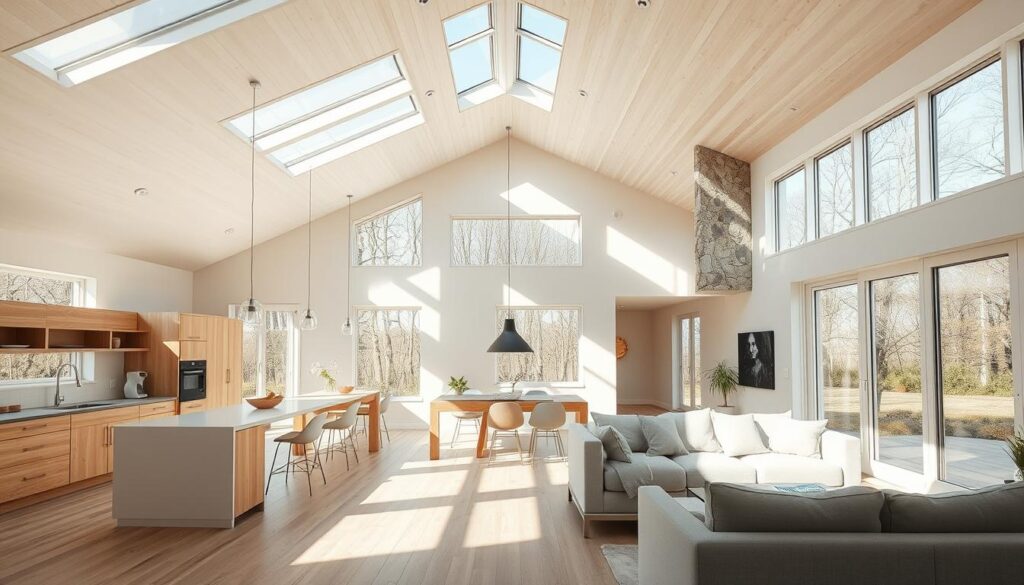
Choosing the Right Windows
Choosing the right windows is key for more natural light. Think about these when picking windows:
- Window Size and Placement: Big windows and smart placement bring in more light.
- Window Type: Sliding, casement, or bay windows let in different amounts of light. Pick what you need.
- Glass Type: Clear or low-E glass lets in more light and saves energy.
Choosing the right windows boosts natural light in your home. It makes your living space more comfortable.
Personalizing Your Space
Personalizing our modular home is more than looks; it’s about telling our story. We make it truly ours by adding our unique touch to the modular home interior.
Incorporating Personal Touches
We start by adding personal touches to our home. This includes family photos, heirlooms, and unique decorative items. These reflect our interests and experiences.
A vintage rug can warm up a room and add character. Travel souvenirs can spark interesting conversations. By carefully choosing and placing these items, we make our modular home design personal and welcoming.
The Role of Artwork and Decor
Artwork and decor are key in making our home personal. By picking pieces that speak to us, we add depth and interest to our spaces.
When choosing art, think about our modular home interior‘s style and colors. A bold piece can be a room’s centerpiece, while a subtle one can enhance the decor. Decor items like vases or sculptures add texture and personality.
By adding personal touches and meaningful art, we create a modular home design that shows our style and tells our story.
Sustainable Design Practices
Adding sustainable design to your modular home is a great way to lessen your impact on the environment. We’ll look at how eco-friendly materials and energy-saving appliances make your home healthier and greener.
Eco-Friendly Materials
It’s key to pick the right materials for sustainable design. Eco-friendly materials help lower your home’s environmental impact and make it healthier inside. Here are some top picks:
- Bamboo flooring: Bamboo grows fast and needs less water and pesticides than wood.
- Recycled glass countertops: These countertops are tough and cut down on waste.
- Sustainably sourced wood: Wood certified by groups like the Forest Stewardship Council (FSC) comes from well-managed forests.
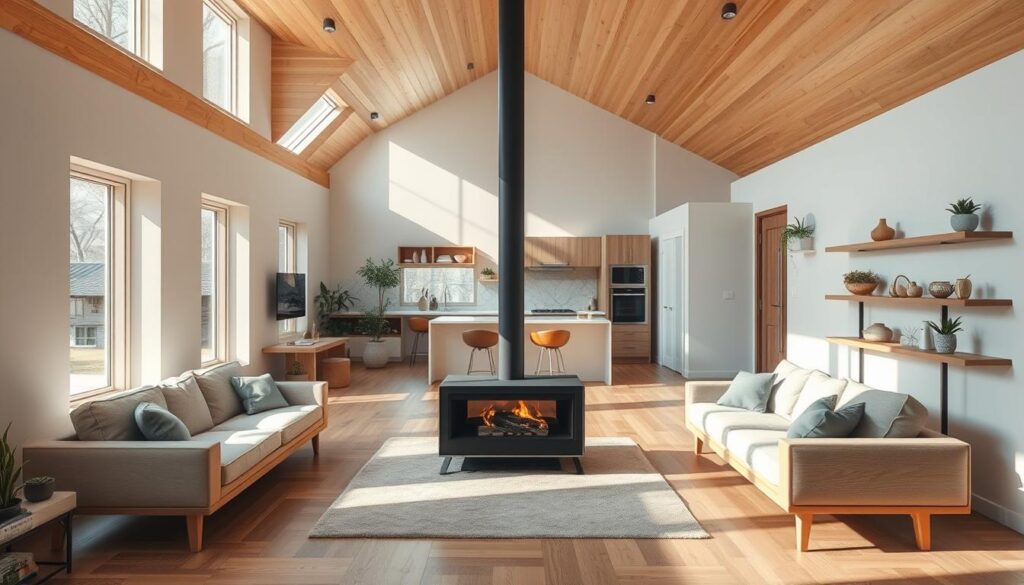
Energy-Efficient Appliances
Energy-saving appliances are vital for green design in modular homes. They use less energy, cut down on bills, and reduce carbon emissions. When picking appliances, look for:
- ENERGY STAR certification: This shows the appliance meets high energy standards set by the U.S. Environmental Protection Agency.
- Smart technology integration: Appliances that can be controlled remotely or adjust based on your schedule save more energy.
By using eco-friendly materials and energy-saving appliances, you can make a home that’s not just lovely but also good for the planet.
Maintenance Tips for Modular Interiors
Keeping your modular home’s interior in top shape is key. It helps keep your home both beautiful and functional. Regular care ensures your home stays a cozy and welcoming place for years.
When designing and customizing your home, think about layout, colors, and furniture. Now, let’s dive into the practical side of keeping your home’s interior in great condition. We’ll explore the best ideas to keep your space looking and feeling fresh.
Effective Cleaning Strategies
Set up a cleaning schedule to keep your home looking its best. Dust, vacuum, and clean appliances regularly. For customizing your home, use multi-purpose cleaners that work on different surfaces.
Seasonal Maintenance for Longevity
Seasonal checks are vital for your home’s long life. Make sure systems and appliances are working right each season. This step helps avoid problems and keeps your home’s quality high.

